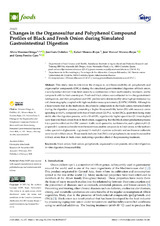Mostrar el registro sencillo del ítem
Changes in the Organosulfur and Polyphenol Compound Profiles of Black and Fresh Onion during Simulated Gastrointestinal Digestion
| dc.contributor.author | Moreno Ortega, Alicia | |
| dc.contributor.author | Ordóñez, José Luis | |
| dc.contributor.author | Moreno Rojas, Rafael | |
| dc.contributor.author | Moreno-Rojas, José Manuel | |
| dc.contributor.author | Pereira-Caro, Gema | |
| dc.date.accessioned | 2021-02-08T08:47:43Z | |
| dc.date.available | 2021-02-08T08:47:43Z | |
| dc.date.issued | 2021 | |
| dc.identifier.uri | http://hdl.handle.net/10396/21040 | |
| dc.description.abstract | This study aims to determine the changes in, and bioaccessibility of, polyphenols and organosulfur compounds (OSCs) during the simulated gastrointestinal digestion of black onion, a novel product derived from fresh onion by a combination of heat and humidity treatment, and to compare it with its fresh counterpart. Fresh and black onions were subjected to in-vitro gastrointestinal digestion, and their polyphenol and OSC profiles were determined by ultra-high-performance liquid chromatography coupled with high-resolution mass spectrometry (UHPLC-HRMS). Although to a lesser extent than in the fresh onion, the phenolic compounds in the black variety remained stable during the digestion process, presenting a higher bioaccessibility index (BI) with recovery corresponding to 41.1%, compared with that of fresh onion (23.5%). As for OSCs, apart from being more stable after the digestion process, with a BI of 83%, significantly higher quantities (21 times higher) were found in black onion than in fresh onion, suggesting that the black onion production process has a positive effect on the OSC content. Gallic acid, quercetin, isorhamnetin, and ɣ-glutamyl-S-(1-propenyl)-L-cysteine sulfoxide were the most bioaccessible compounds in fresh onion, while isorhamnetin, quercetin-diglucoside, ɣ-glutamyl-S-methyl-L-cysteine sulfoxide and methionine sulfoxide were found in black onion. These results indicate that OSCs and polyphenols are more bioaccessible in black onion than in fresh onion, indicating a positive effect of the processing treatment. | es_ES |
| dc.format.mimetype | application/pdf | es_ES |
| dc.language.iso | eng | es_ES |
| dc.publisher | MDPI | es_ES |
| dc.rights | https://creativecommons.org/licenses/by/4.0/ | es_ES |
| dc.source | Foods 10(2), 337 (2021) | es_ES |
| dc.subject | Black onion | es_ES |
| dc.subject | Fresh onion | es_ES |
| dc.subject | Polyphenols | es_ES |
| dc.subject | Organosulfur compounds | es_ES |
| dc.subject | Simulated digestion | es_ES |
| dc.subject | In-vitro digestion | es_ES |
| dc.subject | Bioaccessibility | es_ES |
| dc.title | Changes in the Organosulfur and Polyphenol Compound Profiles of Black and Fresh Onion during Simulated Gastrointestinal Digestion | es_ES |
| dc.type | info:eu-repo/semantics/article | es_ES |
| dc.relation.publisherversion | http://dx.doi.org/10.3390/foods10020337 | es_ES |
| dc.relation.projectID | Gobierno de España. FPU16-05881 | es_ES |
| dc.relation.projectID | Gobierno de España. FJCI-2015-26433 | es_ES |
| dc.relation.projectID | Junta de Andalucía. PP.AVA.AVA201601.20 | es_ES |
| dc.rights.accessRights | info:eu-repo/semantics/openAccess | es_ES |

